
|
Back to |
| The Front Page |
| The Game |
|
The ins and outs of the in-ball-out-ball game
by Mik Mehas Posted July 10, 1998 [This article is co-published by the National Croquet Calendar and Croquet World Online Magazine; editing and situation charts by Garth Eliassen; photo by Bob Alman] |
|
||||||
For most of the 90's, Mik Mehas has been one of the most consistently successful competitors in American rules croquet. Though he has spent a lot of that time on the "outs" with the national organization, he has nevertheless qualified in the last couple of years for American selection in the top tournaments and team events, including the 1997 World Championship in Bunbury and the Solomon Trophy teams for both 1997 and 1998. (Mehas is the only American Solomon team member to repeat in 1998.) He won the 1997 USCA National Championship in International Rules. In Mehas' "bad" years, it wasn't just his deportment and costumes that got him into trouble - it was also the way he played the game. Very early in his playing career, he embraced the "out-ball" strategy as a routine opening play - much frowned upon at the time by many in the American croquet establishment. But Mehas was one of the players (another is Robert Fulford) who have conclusively demonstrated that keeping balls out of the game is, indeed, a legitimate winning strategy for players at the top level. This article is an anecdotal account of how and why he has championed this uniquely American opening.

|
| Two of the most successful practitioners of American Rules "balls out" strategy - Mehas and world champion Robert Fulford - contested 3 games in the 1998 Arizona Open. The Mehas on-court profile invariably includes baseball tights, back-pocket towel, and pony tail. |
When I played my first Calzona event [between top teams from California and Arizona] as a member of the Beverly Hills Croquet Club in 1989, I had only been playing croquet a few months and had competed in only a couple of tournaments. I had no opening strategy and no understanding of opening play.
My first opponent was Jim Bast, a very experienced player, a former national champion as well as Arizona's top player. I asked my mentor, C. B. Smith, what I should do to have a chance of winning. "He can't run two breaks until you go through the first wicket," C. B. said. "Besides, he hates the out-game."
I won the coin toss and, of course, chose blue and black. Blue laid up about twelve inches in front of #1. Red missed the jump shot, and Bast was definitely not happy. I figured that if a miss could upset him that much, I was on the right path. I entered with black and set at #2. Yellow entered, then missed the roquet on black. The in-game-out-game began, black and yellow playing one-on-one inside and blue knocking red around in front of #1. I went on to win the game on my way to a 6-0 record in singles play.

The out-game at the Calzona had allowed me to beat a much better player. It also helped me beat some other excellent players: Ren Kraft and Rory Kelley. I figured I would now use these tactics against everyone I played, and I have been doing that for the past nine years. Now I even choose my doubles partners based on their willingness to play the out-game.
Another good reason for the out-game, besides serving as an equalizer, is to allow time for warming up, which most tournament directors don't allow before each game. By playing the out-game and knocking around balls in front of #1 and playing a two-ball game on the court, you can warm up and get a feel for the court before real break play begins - especially important for the first game of the day, after a break between games, or starting play on a different court.
Flexibility is the key
In playing the out-game, flexibility is the key. If you have a choice, always take blue and black and block with blue, because that forces the opponents to make two jump shots to get in the game. If you've blocked with both blue and black, the opponent's second jump shot has to go over two balls.
If the opponent succeeds by bringing one ball, say red, into the game, which do you bring in: blue or black? One way is to bring blue in so it can play ahead of red on court and black can play ahead of yellow behind #1, keeping it out of the game. Or you might choose to enter with black, depending on your intent.
EXAMPLE: Blue and red are out of the game, black and yellow are in the game. If black or yellow are out on the court (instead of on the line) and one or both are set up at #2, #5, #6, or 1-back, then clear #1 with blue, make a roquet, and run the three-ball break. If red is set at #1 and ready to enter on its next turn, it can be cannoned out of position before or after black makes 1-back. If you're going all the way to rover, the disruption of red at #1 is essential, allowing you to set a three-ball break for black anywhere on court without having to worry about red hitting in.
ANOTHER EXAMPLE, with blue and yellow out and red and black in: Jockey for position behind #1, getting blue in position to enter while leaving yellow far enough away to make unlikely its chances of driving blue away. Black can then try to roquet red and set a three-ball break for blue. If yellow misses blue or lags to position behind #1, blue can enter and run the break. When finished with the break, red, shooting next, should be left a long shot at blue or black which will make it easy for black to pick up red if it misses and embark on the second break.
If the first break for blue or black is difficult to establish and it is unlikely that it will go all the way to rover, it is important to at least get past 1-back to deprive the opponent of one clearance.
What if red and yellow both make it through #1, leaving blue and black still blocking?
The first thing to do is make sure that blue and black are both in position to easily clear #1, preferably with considerable control. That way, blue and black are in control of the west side of the court and the opponent can't set up at #2.
Then, depending on the situation and the ability of the opponent, I might enter the game with one ball, say blue, and take cross-court shots hoping to hit red or yellow and then set black with a three-ball break with blue and yellow. Blue, the hunter, would have to be careful, of course, not to leave itself after a roquet attempt where red could easily pick it up and set for yellow or roquet yellow, then "crout" (drive it out-of-bounds on the croquet stroke) it to blue. This is also why black should have excellent position at #1: if the opponent does set a break, black has to enter with control, roquet one of the on court balls, and disrupt the break. Not always easy to do - but the in-ball-out-ball game is a shooter's game.
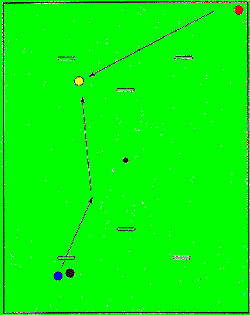
|
| If the opponent leaves a ball on the court - in this case yellow going to position at #2 - blue, shooting next, can clear deep, roquet yellow, and set up a three-ball break for black. If red and yellow have chosen corner III or IV, the west side of the croquet court is dominated by blue and black, waiting to enter. |
The ball in the jaws of #1 waits for the mistake, then pounces
Rhys Thomas, one of the smartest players of the American game, once criticized my out-game in a short National Croquet Calendar article. I carried that article around with me in my wallet and read it just before my next match with Thomas. when we met in the playoffs at the 1994 San Francisco Open. That game went something like this:
Rhys won the toss and chose blue and black. Blue cleared and took corner I. Red blocked. Black jumped, then set an up court line rush for blue. Yellow jumped and went out of bounds behind #1 (in preparation for a transposed Chernobyl or the Flemley Variation).
Blue set a rush for black. Red adjusted, moving closer to #1. Black rushed blue, made #2, but had no rush for #3 so went to corner III, leaving blue deep behind #2.
Then ensued a long game of cat-and-mouse. For the next forty minutes no wicket was scored or even attempted. Black was looking for a rout or an attack for blue. Yellow, the hunter, was conservative, looking for the safe hit-in opportunity. Meanwhile, red was deep in the jaws of #1 waiting for a reason or opportunity to enter.
Finally blue, in corner III with black, set a short rush for black toward #3. Black took the rush but jammed in the hoop, wired from blue. Yellow lagged to near #2, also wired from blue.
Blue retreated to corner I. Red entered, ran the three-ball break to the stake (exchanging black for blue at 2-back), and set a leave.
Blue missed the hit-in attempt. Red finished 26-3.
The rewards and hazards of holding both balls out
An alternative to the Chernobyl or Flemley that I have developed and am particularly fond of is holding back two balls and letting the opponent take the on court risks. Blue or black may sit behind #1 indefinitely, ready to enter while red and yellow are grabbing hoops one at a time and getting off the lawn. As soon as there is a ball left on the court that looks hittable, blue or black clears #1, attacks, and sets a three-ball break for partner.
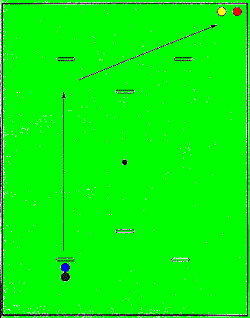
|
| Of course, with blue and black holding back and red and yellow in the game, the score is 2-0 in favor of red and yellow. Neil Spooner's favorite strategy was simply to wait, by passing and adjusting, and force blue and black to eventually enter. When they do, an Irish peel can be followed by a roquet, then an attack setting up blue or black with a three-ball break and leaving the opponent with a cross-court shot. |
Itıs easier if red and yellow sit in corner II. Make the Irish peel, rush to corner II, attack, and run the break. It may take a couple of wickets to clean up the break, depending on where you have rushed your partner ball. In the 1996 Southwest Regional Ray Bell took corner II after clearing #1 and set a rush for yellow to #2. Instead of rushing to #2, however, he rushed yellow all the way back to #1 and tried to cannon out blue and black, which were set for the Irish peel. The cannon missed, leaving yellow on the lawn half way to #2; he retreated with red to corner IV. Black came in, ran the break, set the leave, and finished 26-3.
If red and yellow have set in corner I, or on the boundary directly behind #1 as Jacques Fournier did at a Firestone purse tournament, the attack is easy. In that game, blue drag-jumped black through the hoop, then gently roqueted it, then took off to red and yellow, hit red, rushed yellow to black in front of #1 (leaving red wired from black and yellow), and finally set up at #2 leaving a three-ball break for black. This way, if red shoots at blue and misses, then black roquets yellow to start the break, peels blue at #2, picks up red on the north boundary, and has a four-ball break. As I remember, however, Jacques, full of confidence, shot at blue, hit, and ruined my party.
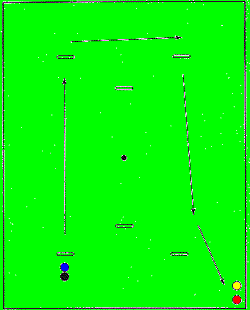
|
| More difficult is the attack to corner IV. After an Irish peel, black can two-ball #2 and #3, then attack to corner IV. In the 1991 San Francisco Open, Barry Chambers from Australia didn't wait to clear #3: after clearing #2 he rushed to #4, attacked, rushed the opponent's forward ball back to #3, cleared, and went straight into a 4-ball break. |
If red and yellow set in corner IV, attacking is far more difficult. If both balls can be brought in on an Irish peel, then hopefully #2 and #3 can be two-balled, then partner rushed to #5 and red and yellow picked up before #4 for the break. If #2 or #3 are missed, however, that gives the ball game to red and yellow. Arizona's Pat Roach recently turned the tables and gave me problems when he attacked from corner IV. The first time, he cannoned me out of position, which is no big deal because you are back in position next turn. But the next time he cannoned me into the game, then ran around.
When the battle at #1 lasts the entire game
If the opponent doesn't get both balls into the game and you enter an in-ball-out-ball game, the battle at #1 can last all game. A couple of examples come to mind:
The first time was in 1991 in the Texas Classic when I was playing doubles with Rory Kelley against C. B. Smith and Joe Yoder. Joe was over-enthusiastic, cheering every time he made a roquet or cleared a hoop, so Rory and I decided to see if we could quiet him down a bit. I set blue at #1. Yoder missed the jump shot with red, so the game was on. Black and yellow entered. Thirty-five minutes later black was at 1-back but dead on yellow, yellow was set at #5, blue had a ten-foot shot to enter with balls in perfect position, red was out of position to clear #1. After a brief discussion with Rory it was decided to that I should clear #1, run the break, and set black to finish before red could enter.
I ran blue around. Red lagged to position in front of #1. Black made 1-back, cannoned red out of position at 2-back, but then clanked the hoop. Yellow missed the hit-in.
Blue hit black and set the break again. Red took shape. Black made 2-back, again cannoned red out of position, made 3-back, but broke down at 4-back. Yellow missed the hit-in.
Blue rushed black behind #1 and again cannoned red out of position. Black finally finished, 26-4.
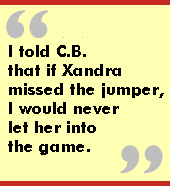
Another good example was in the 1995 USCA Southwest Regional in another doubles match. This time I was playing with C. B.‹in one of his last tournaments before retiring from competition, against Don Fournier, Jr., and Xandra Kayden. After we won the coin toss, I told C. B. that if Xandra missed the jumper I would never let her into the game. I knew she would relish the opportunity to play the out-game against me, especially at the beautiful Sherwood Country Club. I set blue at #1. Xandra, playing red, drove blue deep - a big mistake, because she also went out of position. Black and yellow entered.
Sixty-five minutes into the game black and yellow were on the peg and blue and red were still battling at #1. C. B., against my wishes, got cute and tried to peg out yellow. He missed, and yellow pegged out him instead. I said, not to worry: I would enter in last turn with Xandra out of position. Yellow pegged out in last turn. Blue entered for a one-point lead. Red couldn't. Final score: 14-13.
Choosing the correct ball positions for defending #1
When you're playing the in-ball-out-ball game, you want to position your out-ball three to fifteen feet south of #1, where you can easily drive away the opponent's out-ball. You should also set up slightly on the opposite side of the opponent's ball so if you are driven away, the opponent will also be out of position to make the hoop; then you, shooting next, will be the first back to hoop position or - if you want to continue the battle - to defensive position where you can drive away the opponent if he sets up. You should also try to stay on the short side of the lawn (west of #1), to keep from being hit too far away. If you have to, you can also use #1 hoop to wire yourself from the opponentıs ball.
During an Arizona Open a few years back I was playing against a great shooter, Phil Arnold, in one of his last American rules games: Playing blue and black, I set blue at #1. Red missed the jump. Black entered and set at #2. Yellow entered, roqueted black, and promptly two-balled eight hoops. Phil was on his game. Being so far behind I thought I had better get some points. Well, it wasn't that easy: yellow, never missing a hit, took black out every time I set up.
Thirty-five minutes into the game both black and yellow were on the
stake. Although yellow had arrived at the peg fifteen minutes before
black, it was helpless to stop black because blue, now playing
defensively, wouldn't enter (if yellow, as a rover, played off black it
would be dead on black
Another thirty minutes later Phil did one of his famous American rules
brain-dead moves. With my blue in position to enter at #1, Phil shot red
(still not in the game) to yellow in corner IV. I scratched my head,
wondering if I had missed something. There was a buzz in the crowd
gathered to watch the late afternoon game. I sent black to #2.
Yellow set a rush for red to #2.
Blue cleared #1, made #2 off black, then rushed black past #4 and
picked up yellow for black, then set at #3. Phil looked at me oddly as
if I were brain dead, then calmly shot red into black. Fault. The balls were
replaced, and yellow never got another opportunity. The final score was
17-14.
Mehas versus Osborn and Fulford: great players play great games
A couple of days later I was playing one of the best American rules
players in the country: Johnny Osborn. Oz entered with blue to corner I.
Red blocked. Black missed the jump. Yellow jumped, then lagged to #2.
Blue passed. Red blasted black near #3 and was left with an iffy
fifteen-foot angled shot at #1. Black lagged to #1, short. Yellow made
#2 and lagged to #3.
Blue attempted #2 from corner I but missed, going out of bounds
northeast of #2. Red somehow made #1 and shot softly to yellow. Black
went out of bounds behind #1. Yellow two-balled #3, #4, and #5, then had
a hampered shot at red, nicked it to halfway between #5 and #1, then
took off toward blue on the north boundary, but missed the roquet
attempt.
Blue tapped yellow, took off to #2 and cleared, then barely missed the
roquet on yellow. Red lagged to #6 to give yellow the three-ball break.
Black came screaming through #1 from the end line, stopped six inches
from blue and yellow, then ran the break to rover and set a killer leave
for partner. Yellow missed the hundred-foot boundary shot. Oz ran blue
around and finished. Great players play great games.
In the 1991 Masters tournament in Dallas, I was playing Robert Fulford,
currently the best player in the world: I laid up blue. Fulford jumped red,
went to corner I. Black laid up eighteen inches behind blue. Robert stared at
the setup for at least three minutes, trying to figure out what to do.
Finally he smacked
yellow with top spin, drove black to the right and blue to the left,
then rolled through the hoop, all in one shot. I couldn't believe it. On
the continuation Fulford went to red. Both my balls were out of position
and he had a rush for red to #2.
Blue set up eighteen inches from #1. Red rushed to #2, cleared, but had
no rush to #3 so he went to corner III. Black lagged to close position
at #1, directly in front of blue. Yellow went to red, setting a rush for
#3.
Blue drag-jumped black into the game, then rushed it ten feet short of
#3, took off to red and yellow in corner III where an easy four-ball
break waited; instead, I missed a two-foot roquet on red and the
advantage changed. Fulford, warming up, went all the way with red, then
left black near corner IV, blue hidden behind #2, and red and yellow on
the nine-inch line near corner II. A large crowd was watching the game,
enjoying brunch. I ordered a glass of wine from someone, certain that I
would miss my next shot, which would be my last. I shot black cross court
at red and nicked it. As I'm walking up the lawn, I decided to give
Robert the same shot he left me so if he missed I could peg out red with
blue. Yellow missed. I ran blue, peeled black after 1-back, staked out
red, then finished for a 26-13 win.
An encore against Fulford in Arizona
In this year's Arizona Open Fulford never entered the game with both
balls in opening play. In all three games that I played with him the
opening was the same: I chose blue and black, or he chose red and
yellow. I also decided that I could not beat Robert with the out-game,
because he shoots better than I do and his strategy is superior to mine.
So, for the first time in my tournament career, I entered with both
balls:
I always cornered blue where the boundary was in poor condition because
I figured Fulford would try to hit with red. I figured that if he missed
I got the first three-ball break. If he hit, he got the break if I
didn't hit in. In all three of our games, red missed and I got the first
break by setting up blue with black and red. I knew Robert would not
enter yellow unless he was certain he could hit; he figured anyone could
run the first break around, but he would get control before the second
break. My plan was to run blue around, peel black at #2, cannon yellow
out of position, and retreat to corner III. After red shot, black would
join blue to attack anywhere yellow joined with red.
Robert won two out of the three games we played, including the final.
It was the first time I had ever lost to Fulford, either in American- or
Association-rules
play.
What else is important in the in-ball-out-ball game? Know the rules.
There are a number of rules applying to balls in the game that don't
apply to balls out of the game and vice versa: when you can hit another
ball and when you can't; when you can lift a ball and when you can't.
Damon Bidencope once told me that he wins one extra game in every
tournament by thoroughly knowing the rules.
Blue would clear and go to corner I. Red would clear and start the
Chernobyl, going out of bounds on the south boundary below #1, about ten
to twelve feet away from blue. Black would join blue. Yellow would set,
slightly to the left so a ball going through 2-back couldn't move it out
of position (Fulford thinks of everything!).
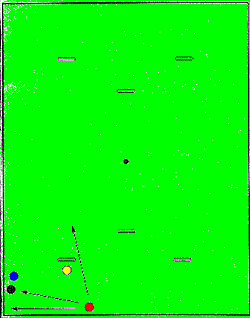
With red going out behind #1, yellow set to clear, and blue and black in
corner I, red has the choice of moving closer to harass blue and black
(passive), trying to hit the opponent's back ball for a rush with the
forward ball (the Flemley), or setting in front of #1 for yellow (the
Chernobyl). In either case, there isn't much opportunity for blue and
black, and red and yellow have effectively seized control of the
opening.